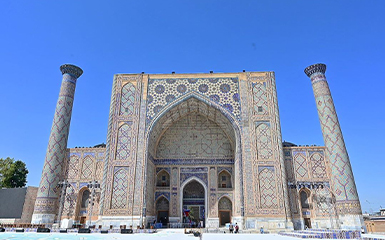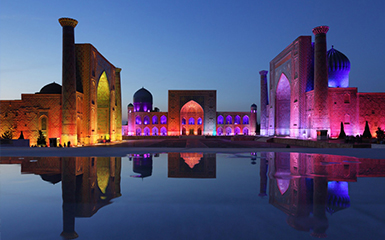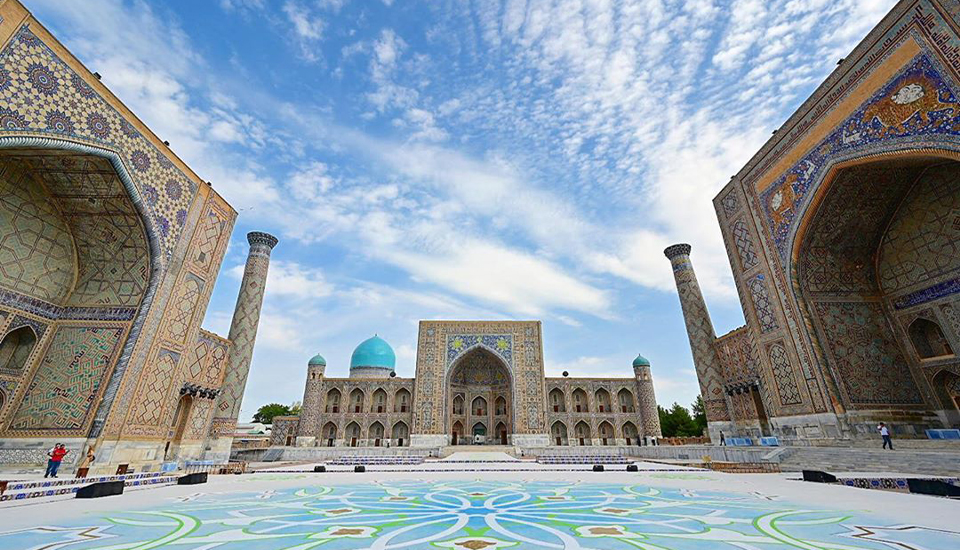Bahauddin complex
Char Minar
Lyab-I Hauz complex
Poi Kalan complex
The Ark Citadel
Bolo Haouz Mosque
Kalan Minaret
Islam Khodja complex
Itchan Kala
Kalta Minaret
Kunya Ark
Kutlugmurat Anak
Alla Kuli Khan
Muhammad Rahim Khan
Muhammed Emin Khan
Pahlawan Mahmud
Tash Hauli
Juma Mosque
Andijan
Muynak
Rabati Malik
The Registan in Samarkand is one of the most magnificent places in Central Asia. It is the heart of the ancient Samarkand. The ensemble of three madrasas is considered a unique example of the art of urban construction and architectural design of the city's main square. The three madrasas are the Ulugh beg Madrasa (1417–1420) on the west side, the Sher-Dar Madrasah (1619–1636) on the east side, based on the Kosh principle, and the Tilya-Kari Madrasah on the north side of the square (1646-1660). East of the Tilya-Kari-Madrasah is the Shaybanid mausoleum from the 15th century.
The Ulugh beg Madrasah faces the square with its mighty portal and a lancet arch. The corners are decorated with tall, proportional minarets. A mosaic panel above the entrance arch is decorated with a geometric ornament. In the square courtyard there is a mosque, classrooms and, on the edge, rooms that used to be the living quarters of the students. Deep niches (corridors) are spread out around the axis.
Originally, the Ulugh beg madrasah looked very different: a two-story building with four domes over the classrooms, which were located in the corners of the madrasah. The Ulugh beg Madrasah was one of the most prestigious universities in the entire Muslim world in the 15th century. The famous scientist, philosopher and poet Abdurrahman Djami studied in this madrasa. Ulugh beg also gave his lectures here. During his reign, this madrasa remained a centre of science.
The ruler of Samarkand, Yalangtush Bakhadur, ordered to build the Sher-Dar and Tilya-Kari madrasas in the 17th century. The Sher-Dar-Madrasa (tiger containing madrasah) was the work of the architect Abdujafer. The construction of the madrasa is not as finely divided as that of the corresponding buildings from the 15th century (the golden era). Nevertheless, the harmoniously arranged large and small rooms, the finely divided pictures of the mosaics, the monumentality, but also the functional symmetry of this madrasa are among the most impressive architectural monuments in Samarkand.
Ten years later the Tilya-Kari-Madrasah (gold-plated madrasah) was built. This madrasa served not only as an academic teaching facility, but also as one of the most important mosques for a long time. The Tilya-Kari-Madrasah has a two-story main facade, a large, wide courtyard with small living rooms on the edge, and four corridors that are arranged around the axis. The mosque building is in the western part of the courtyard. The main hall of the mosque is richly gilded. The Registan ensemble represents a successful combination of buildings from different eras that are currently subject to extensive reconstruction work.


